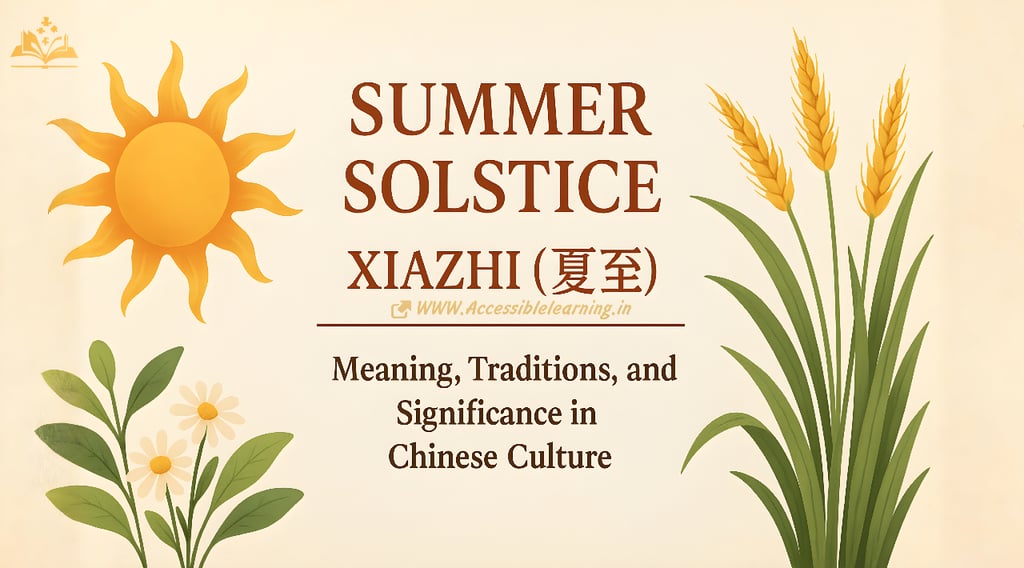
Summer Solstice (Xiazhi): Meaning, Traditions, and Significance in Chinese Culture
Discover the rich traditions, meaning, and wellness wisdom of Xiazhi—the Summer Solstice in Chinese culture. Explore its historical roots, TCM health tips, ancient rituals, and modern revival in this in-depth guide.
CULTURE/TRADITIONEVENT/SPECIALCELEBRATION/FESTIVALSCHINESE HISTORY
Kim Shin
6/17/20255 min read


The Summer Solstice, known as Xiazhi (夏至) in Chinese, marks one of the 24 traditional solar terms in the Chinese lunisolar calendar. Celebrated around June 21st, Xiazhi represents the longest day and shortest night of the year in the Northern Hemisphere. While it may pass unnoticed in the Western world beyond astronomical circles, in Chinese culture, Xiazhi carries deep seasonal, agricultural, and spiritual meaning.
What Is Xiazhi (夏至)?
The term Xiazhi literally means "Summer Reaches" or "Summer’s Extreme." It denotes the point when the Sun is directly over the Tropic of Cancer, creating the maximum duration of daylight in the year. It is the 10th solar term in the Chinese calendar and often marks a shift in yin and yang energy balance, where yang (light, heat, activity) reaches its peak and yin (darkness, coolness, rest) begins to rise.
Key Xiazhi Facts
Usually falls on June 21 or 22.
Represents the peak of solar energy.
Solar longitude: 90°.
Historical & Cultural Origins
The earliest records of Xiazhi date back to the Warring States Period (475–221 BCE) and became systematized during the Han Dynasty. The solstices and equinoxes were crucial to agricultural societies that depended on accurate seasonal divisions for planting and harvesting.
Imperial China celebrated the summer solstice with rituals honoring Yin energy and the Earth—a counterpart to the Winter Solstice (Dongzhi), which honored Yang energy and Heaven.
In ancient times:
Sacrifices were made to Earth gods, especially at the Earth Altar in Beijing.
Farmers offered thanks for the maturing crops, especially wheat and rice.
The elite and commoners alike used the day for rest and reflection.
Traditional Customs & Festivities
While Xiazhi is not a public holiday in modern China, several regional customs have survived or been revived, often intertwined with local beliefs and food traditions.
Eating Cold Noodles (Liangmian 凉面)
In many southern regions like Jiangsu and Zhejiang, people eat cold noodles to beat the summer heat. The practice symbolizes coolness and ease during hot days.
Worshipping the Earth Goddess
In parts of China, people worship the Earth Goddess (Houtu) with rituals that involve offerings of fruits, grains, and incense, thanking her for fertility and protection.
Balancing Yin and Yang
With yang energy at its peak, it’s considered essential to nurture yin. People focus on cooling foods, resting during midday heat, and practicing yin-oriented exercises like tai chi or meditation.
Feng Shui Adjustments
Some practitioners of Feng Shui use Xiazhi as a time to adjust home energy flows, placing emphasis on shading, water elements, and east-facing energies to counteract excessive heat and dryness.
Health Practices & Summer Solstice Wisdom
In Traditional Chinese Medicine (TCM), Xiazhi marks a sensitive period when excessive heat can disturb the heart and mind. As a result, the solstice comes with wellness guidelines:
Eat cooling foods: mung beans, watermelon, and cucumber.
Avoid spicy and greasy food.
Drink herbal teas to reduce internal heat.
Rest during midday and rise early.
Practice qi gong, tai chi, or light yoga.
TCM believes maintaining a yin-yang balance during this high-yang time is essential to avoid issues like insomnia, irritability, or heatstroke.
Astronomical Significance & Global Context
While Xiazhi is culturally specific, the Summer Solstice is a global event celebrated in various ways:
Stonehenge (UK) sees thousands gather to welcome the sunrise.
Inti Raymi (Peru) honors the Incan Sun God Inti.
Midsommar (Sweden) features flower crowns and maypole dancing.
In India, it often coincides with the International Day of Yoga.
But the Chinese Xiazhi stands apart in its philosophical emphasis—more reflective and harmonizing than celebratory.
Xiazhi in Modern China
Today, Xiazhi isn’t marked with national events, but awareness is growing, especially among young urban Chinese who are rediscovering the 24 solar terms as part of their cultural heritage. Schools may hold educational activities, and digital calendars now highlight Xiazhi along with suggestions on wellness, food, and mindfulness.
It’s also being promoted as part of "intangible cultural heritage" by scholars and conservationists aiming to preserve these subtle yet powerful seasonal traditions.


Fascinating Facts Xiazhi (夏至)
The Day with the Longest Shadow at Noon
While Xiazhi is the day with the longest daylight, in China, it's also when the noon shadow is the shortest. Ancient Chinese astronomers measured these shadows using a tool called a gnomon (a vertical pole) to calculate the Earth’s tilt and seasons.
“Grain in Ear” to “Summer Solstice”: A Critical Agricultural Window
Xiazhi falls right after the “Grain in Ear” (Mangzhong 芒种) solar term. Between these two points is a peak time for harvesting wheat and preparing for rice transplantation in southern China. It’s a labor-intensive, high-stakes phase for farmers.
Xiazhi Is Hot… but Not the Hottest
Contrary to what many might think, Xiazhi doesn’t bring the hottest temperatures. The actual heat peaks about 20–30 days after due to the Earth's landmass slowly absorbing and releasing heat—this period is known as Sanfu (三伏天) or the “dog days of summer.”
Earth Altar Sacrifices in Ancient Beijing
During the Ming and Qing Dynasties, emperors would perform rituals at the Altar of Earth (Ditan Park) in Beijing on Xiazhi. This complemented the Winter Solstice’s Heaven Worship at the Temple of Heaven—perfecting the yin-yang duality in imperial rites.
Spiritual Reset for the Second Half of the Year
Xiazhi serves as a spiritual checkpoint. Traditional beliefs see it as the time when Yang energy begins to wane, inviting people to prepare their minds, homes, and diets for the coming slower, darker seasons. It’s a moment for internal reflection and course correction.
Solar Term Recognition by UNESCO
The 24 Solar Terms, including Xiazhi, were officially recognized as part of UNESCO’s Intangible Cultural Heritage in 2016. This highlighted the incredible depth of Chinese time-keeping and environmental wisdom—a system that evolved without modern technology but stayed aligned with nature.
Cold Dishes Became a Cultural Icon
The widespread cold noodle tradition isn't just about taste—it became a symbol of health consciousness and harmony with the environment. Some families even create five-color cold dishes (representing the five elements: wood, fire, earth, metal, and water).
The Yin-Yang Clock Starts to Turn
In Daoist cosmology, Xiazhi marks the "turning point"—when Yin energy begins to subtly return after Yang reaches its zenith. This quiet transformation is mirrored in personal energy shifts and used in Daoist meditation and breathing practices.
Mnemonic Rhyme Used by Farmers
Old farmers remember Xiazhi with traditional rhymes:
“Xiazhi rice heads nod, plant on time or your field's a fraud.”
Such verses helped guide planting, fertilizing, and harvest schedules before modern tools existed.
Modern Revival via Digital Culture
Young Chinese are rediscovering Xiazhi through WeChat posts, Douyin videos, and wellness apps, many of which provide
Seasonal food tips
Animated solar term updates
Ancestral wisdom for modern stress management
The Summer Solstice (Xiazhi) is more than just a date on the calendar—it’s a moment of cosmic pause, an invitation to align with nature’s rhythms. In a hyper-digital, fast-paced world, the wisdom of Xiazhi calls us to:
Honor the Earth
Balance activity and rest
Eat with the seasons
Protect our well-being
As the sun shines at its fullest, Xiazhi encourages a return to inner stillness, to harmonize with the quiet rise of yin, and to welcome the hidden coolness within the heat.
Subscribe To Our Newsletter
All © Copyright reserved by Accessible-Learning Hub
| Terms & Conditions
Knowledge is power. Learn with Us. 📚


